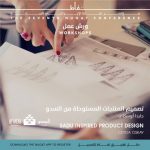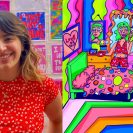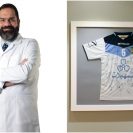We’d like to introduce our brand new #online series in collaboration with Nuqat: The Social Interview. Get to know the talented individuals who will be conducting this year’s series of workshops. We chatted with Ceyda (Jeyda) Oskay, who will be conducting the Sadu Inspired Product Design Workshop.
Do you have to be an artist to be creative?
I think creativity can exist in many ways and that it is not necessary to be an “artist” to be creative. It just means being open to trying new things and making mistakes and valuing discoveries that come through the process.
To you, what does it mean to be creative?
In the arts, I think it is to see things differently and be able to communicate this vision by creating something that speaks to one or more of the senses.
Who are your industry heroes?
I love what Laila Al-Hamad did with Zeri Crafts and her use of the Sadu-inspired patterns! Academically, Sheikha Altaf’s research and publications on the craft, and her work on the Sadu House, I deeply respect. With the traditional Sadu weavers at the Sadu House, I really like Muteira’s non-traditional and original pieces, and Laila’s work for her invention of new symbols and excellent technique.
In terms of contemporary fiber art, what inspire me are: the fabric books and sculptural work of Louise Bourgoise, the later weavings of Lenore Tawney, boro work of Jody Alexander, unusual and expressive knits of Annie Coggan, gloved hand sculptures of Maha Malluh, Susan Hefuna’s patched words, and always Eva Hesse’s fiberglass work that closely resembles fiber and textile.
It was also great to have Manal Al-Dowayan come to Kuwait and show her “Sidelines” piece of a giant collective weaving piece parallel to the SADI (Sadu Art & Design Initiative) artist exhibition. I really enjoyed talking to her about contemporary art, and her approach towards social issues and participatory art-making!
What are the benefits of participating in your workshop as a part of Studio Nuqat?
The workshop explores the history and meanings of the Sadu weaving, and builds upon that through textile design methods. Thus, participants do artistic research, and combine this with technical skills to design a pattern for a product or create a contemporary piece of artwork. At the end, if the Sadu House likes the work, it can be a piece in the gift shop!
Why do you think these workshops are important to the cultivation of the creative economy?
I think it is important to see the place of craft in traditional creative economies. At the same time, it is also important to be able to create a new product. Genuinely re-exploring something in heritage, rather than a cut and paste of something that does not mean much to us, often gives the new product more depth or meaning. On a very practical level, the participants have the opportunity to create something that can be sold in the Sadu House gift shop.
What is the most challenging aspect of succeeding in a career in the creative industry?
It is difficult to show that ideas that we may be able to come up with very quickly, actually come out of hours of “invisible” work and processes – through research and exploration, trial and error, non-creative times, etc…
It is also difficult to explain ideas or what we envision in our minds to a non-visual person.
If you could attend another Studio Nuqat workshop, which one would it be?
They all look great, but I think the mural painting would especially be really fun!
Check out Ceyda’s work on Instagram @CeydaOskayArt. To find out more about this year’s Nuqat conference, follow them on Instagram @nuqat. Register on the website, www.nuqat.me, and be sure to download their app via eventtus to view the complete Nuqat Conference schedule and REGISTER through their new app! To download the app from the Apple Store click here and from Google Play click here. BONUS: GET 10% OFF when you use PROMOCODE bazaarXnuqat!












